|

by Bart Bakker – 15/08/2013 – miniFabLab ‘What is the name of a gentleman from jewish heritage who wrote a book
and started a movement to learn young people how to work with modern technology?’
Yes, it was the Dutch tech writer Leonard de Vries.
During WWII, when he hid from the nazi’s, he wrote a book ‘De Jongens van de Hobbyclub’,
‘The boys from the Hobby Club’. It was published in 1947. It is about a group of teenagers that could experiment with the most advanced technology of that time:
building your own radio, recording sound, filming, even radio controlling a model boat. For kids in the sober postwar
time this was a dream; most of their fathers did not even have an electric drill.
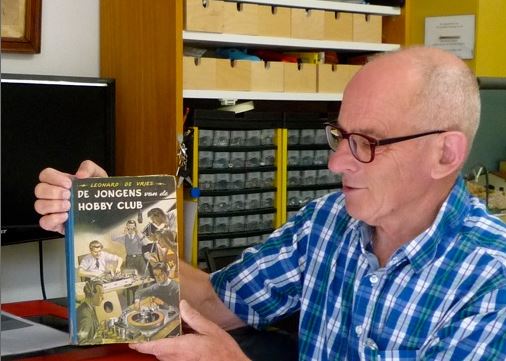
http://fablab.nl/2013/08/15/correct-quiz-answer-leonard-de-vries/

66 years MakerFaire tradition in Holland At the MiniMakerfaire, 7/8 September 2013, in Kerkrade Fablab Maastricht will present
its new mobile fablab in a 50 year old restored tricycle.
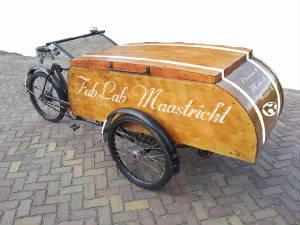
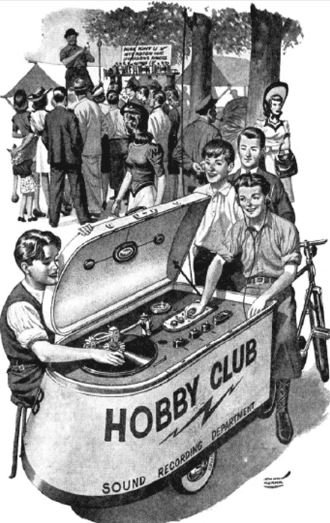
In the Leonard de Vries book, ‘The boys from the Hobby Club’, I mentioned last week there is this drawing of a
Dutch Faire in 1947.
29/08/2013 | Bart
Bakker |

De Jongens van de Hobby Club (The Boys of the Hobby Club) A group of Dutch High School boys forms the "Hobby Club". The goal is
to help each other and to combine their different hobbies. Leo van der Sluis, an enthusiastic radio amateur becomes the president.
The father of one of the members makes the attic available above his company office at the Herengracht in Amsterdam. Their first large project is making a promotion-film with sound
on "records". This is done in cooperation" between the sections: radio, electricity, photography and film. They start a magazine called the "HOBBY CLUB" with subscriptions
from all over the country. They conduct courses in radio technique, Morse, electricity and photography and they also set
up a library, organize excursions to Philips and radio Kootwijk and participate in radio fox hunting. This book was written by Leonard de Vries, a very active Dutch writer, during and
shortly after the war. He wrote more then a 100 books, many of which were translated into other languages. http://www.wimb.net/index.php?s=hobby&page=1

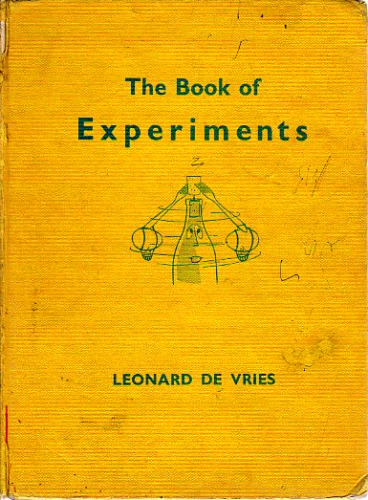
| New Scientist |
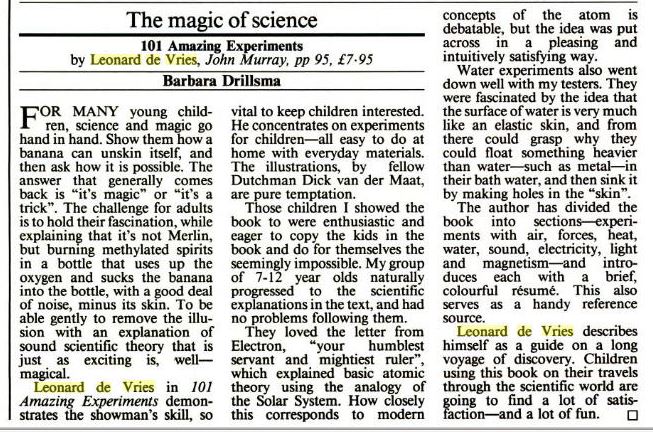
|
| 101 Amazing Experiments, 1986 |

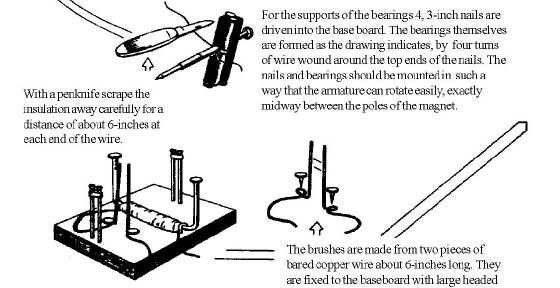
|
| (Click to enlarge) |
Electric motor made out of nails, from the
book of experiments. I tried it. I never succeeded getting the motor to run... (L.H.)

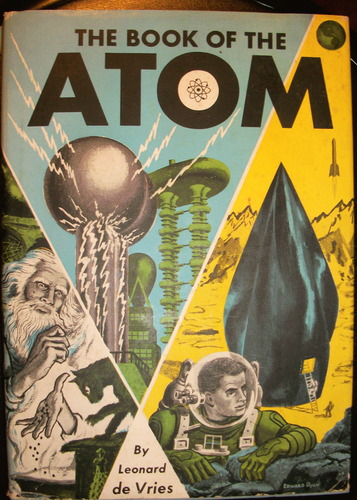
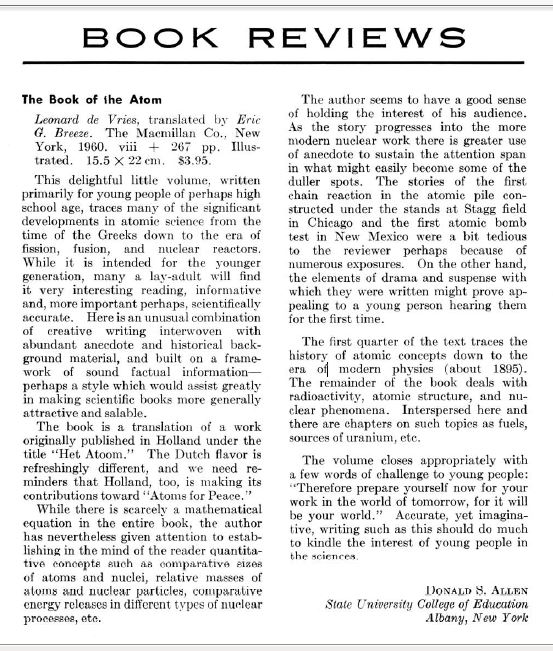
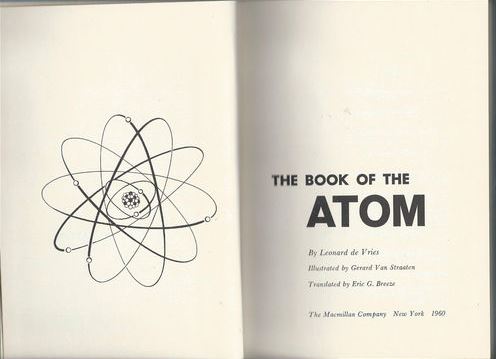

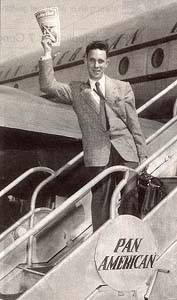
|
| Leonard de Vries, New York Airport, 1951 |
Networks of Empire: The US State Department's Foreign Leader Program 1950 - 1970 - Peter Lang (2008) (Page 222)
 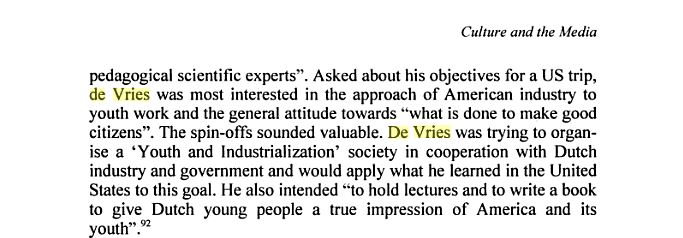

The Romance of Technology in the Cold War Era:
Leonard de Vries and His Hobby Clubs, 1947–1966
ICOHTEC, TICCIH & Worklab joint conference in Tampere,
Finland
10th–15th of August 2010 Dick VAN LENTE Erasmus University Rotterdam, The Netherlands
The late nineteen forties to the early fifties were a period of rapid technological innovation, much
of it related to a wave of automation in industry, the build-up of nuclear weapons arsenals and the introduction of computers
for peaceful as well as military applications. The popular culture of this period reveals profound fears of these innovations,
which threatened employment, human autonomy with respect to machines and life on the planet itself. At the same time, it shows
fascination with technology’s wonderful products, such as plastics and transistor radios. During these years, the Dutch writer Leonard de Vries captured the imagination of thousands of boys
(and a lesser number of girls as well) with a series of books about the adventures of a group of secondary school youngsters
who came together every week to build radios, electrical equipment, and model airplanes, and make photographs and films. The
book articulated a fascination not as much with technology’s products as with the excitement of technological creation
and collaborative work.
Soon after his first book appeared
in 1947, the author started to receive letters from boys who wanted to start such a club. De Vries then created a journal
called Hobby Club, financed in large part from advertisements of industrial and other firms, which served as a kind of paper
guide to the many boys and girls who started clubs. In 1950, 47 clubs existed. Industries were enlisted to support them by
furnishing material and equipment and providing technical coaching. The
movement withered away during the sixties. The paper describes and analyses the remarkable success of this initiative of playful,
hands-on technology popularization during a period when many people were scared and skeptical of new technologies such as
nuclear power and automation. While clearly a grass roots movement,
De Vries and his young followers found much support from industry, which at that time was in great need of young technical
workers and engineers. The decline of the movement will also be discussed: the role of the general decline of youth organizations,
the loss of interest from industry after the postwar reconstruction was accomplished, and the increasing criticism of technology
during the sixties.
Session W1C
Room C5
8:30–10:00

Solidifying the Western Alliance? The Foreign Leader Program (FLP) in
The Netherlands, 1950-1969 Giles Scott-Smith Post-Doctorate Researcher, Roosevelt Study Center, Middelburg, The Netherlands g.scott-smith@zeeland.nl On the cultural side
of the FLP, several people were clearly invited with the specific purpose of writing about their experiences after their return
home. In 1951, 1954, and 1955 the writers Leonard de Vries, Mary Pos, and An Rutgers van der Loeff were given extended trips.
What is noticeable here is that Pos, a proficient traveller, had
already written a book on her previous visit to the USA (Ik zag Amerika, 1941, republished as Ik zag Amerika opnieuw, 1949),
and van der Loeff had also published Amerika: pioniers en hun kleinzoons, a storybook of American history for children, in
1951. Leonard de Vries was a younger writer (32 at the time of his
visit), and the resulting work from his visit, De Hobby Club op Avontuur in de USA published in 1952, was also an educational
adventure story for younger readers. It is revealing to find that Alfons Lammers, later professor of American history at Leiden
university, discovered his interest in all things American by reading de Vries’ book when he was 13.

An Early Maker Story From Holland
By Jan van Cappelle
Posted 2013/06/06
Category, Makers
MAKE-Magazine We think of the maker movement as a modern phenomena propelled by the internet,
the growth of makerspaces, and increasingly affordable digital tools.
But making, of course, is anything but new. Humans
have always been makers.
Jan van Cappelle’s career as a maker began when he read a novel by fellow Dutchman Leonard
de Vries called “The Boys of the Hobby Club.
” Written under Nazi occupation and published in 1947,
it’s essentially the story of a group of boys creating a makerspace before such a word existed.
The book, which
unfortunately is not available in English, had a lasting impact on Jan:
“De Vries showed that you can make something
yourself, in collaboration with others, instead of buying it of-the-rack.” – Stett Holbrook Read here the whole
story: http://blog.makezine.com/2013/06/06/an-early-maker-story-from-holland/


|

